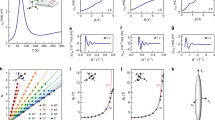Abstract
The effect of the nuclear hyperfine interaction on the dc conductivity of 2D electrons under quantum Hall effect conditions at filling factor ν=1 is observed for the first time. The local hyperfine field enhanced by dynamic nuclear polarization is monitored via the Overhauser shift of the 2D conduction electron spin resonance in AlGaAs/GaAs multiquantum-well samples. The experimentally observed change in the dc conductivity resulting from dynamic nuclear polarization is in agreement with a thermal activation model incorporating the Zeeman energy change due to the hyperfine interaction. The relaxation decay time of the dc conductivity is, within experimental error, the same as the relaxation time of the nuclear spin polarization determined from the Overhauser shift. These findings unequivocally establish the nuclear spin origins of the observed conductivity change.
Similar content being viewed by others
References
C. P. Slichter, Principles of Magnetic Resonance, Springer, Berlin, 1991.
J. Winter, Magnetic Resonance in Metals, Clarendon Press, Oxford, 1971.
I. D. Vagner and T. Maniv, Physica B 204, 141 (1995).
V. Privman, I. D. Vagner, and G. Kventsel, Phys. Lett. A 239, 141 (1998).
A. M. Dugaev, I. D. Vagner, and P. Wyder, JETP Lett. 64, 211 (1996).
B. Sapoval, D. Kaplan, and G. Lampel, Solid State Commun. 9, 1591 (1971).
N. Gauss and A. G. M. Jansen, Czech. J. Phys. 46, S4, 2037 (1996).
M. Dobers, K. von Klitzing, J. Schneider, G. Weinmann, and K. PLoog, Phys. Rev. Lett. 72, 1650 (1988).
A. Berg, M. Dober, R. R. Gerhardts, and K. von Klitzing, Phys. Rev. Lett. 64, 2563 (1990).
A. Schmeller, J. P. Eisenstein, L. N. Pfeiffer, and K. W. West, Phys. Rev. Lett. 75, 4290 (1995).
F. F. Fang and P. J. Stiles, Phys. Rev. 174, 823 (1968).
D. Paget, G. Lampel, B. Sapoval, and V. I. Safarov, Phys. Rev. B 15, 5780 (1977).
A. Abragam, The Principles of Nuclear Magnetism, Clarendon Press, Oxford, 1961, p. 191.
A. W. Overhauser, Phys. Rev. 92, 411 (1953).
S. A. Vitkalov, JETP 82, 994 (1996).
D. Stein, K. von Klitzing, and G. Weimann, Phys. Rev. Lett. 51, 130 (1983).
C. R. Bowers, Solid State Nucl. Magn. Reson. 11, 11 (1998), and references therein.
Author information
Authors and Affiliations
Additional information
Pis’ma Zh. Éksp. Teor. Fiz. 69, No. 1, 58–63 (10 January 1999)
Published in English in the original Russian journal. Edited by Steve Torstveit.
Rights and permissions
About this article
Cite this article
Vitkalov, S.A., Bowers, C.R., Simmons, J.A. et al. Effect of the nuclear hyperfine field on the 2D electron conductivity in the quantum Hall regime. Jetp Lett. 69, 64–70 (1999). https://doi.org/10.1134/1.567985
Received:
Revised:
Issue Date:
DOI: https://doi.org/10.1134/1.567985




